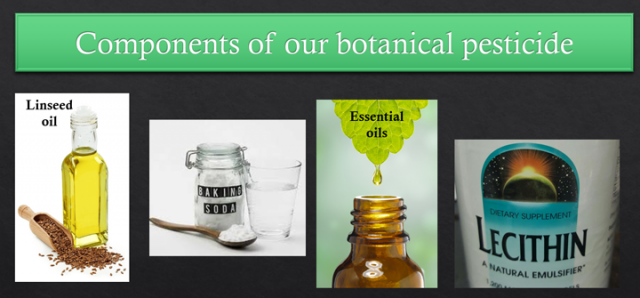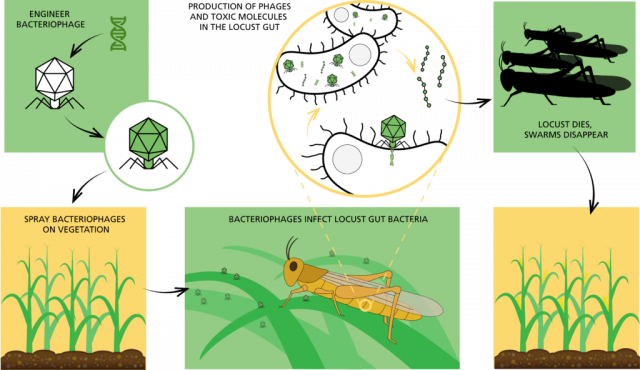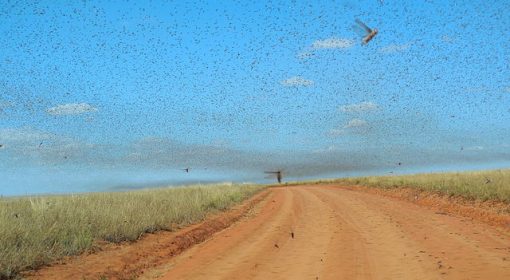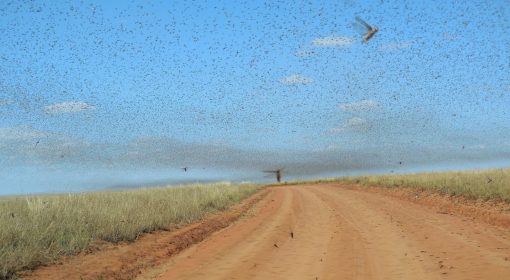In view of the negative environmental impact of pesticides used against locusts, use of biopesticides is being widely promoted. Researchers from University Graz (Austria) have developed a prototype locusticide based on essential oils (such as linseed) that can potentially take us a step further towards minimizing the environmental impact of exterminating locusts.

Pesticides run across the whole gamut of locust management, used on the insects when they are still flightless hoppers, as well as against invading swarms.
For a long time, the pesticides of choice were chemical pesticides. However, their negative effects on the environment and non-target species are now well known and widely acknowledged. Therefore, for several years now, the use of biopesticides is being widely promoted, including by apex organisations such as the FAO.
Currently, the most widely used biopesticide is an oil-based formulation of fungi from the Metarhizium acridum family, available commercially as Green Muscle and NOVACRID. These products are available as powders, which are mixed with oil (diesel, kerosene, or other mineral oils) and sprayed on fields. The fungus in the mixture starts feeding on the insect. In around 3 days, the locust gets weaker, its movements slow down, it is not able to source the food it needs, and eventually dies. Tests show that this biopesticide does not have significant negative effects on non-target animals and plants.
The biggest limitation of biopesticides vis-à-vis chemical pesticides is that they do not act as fast. The Metarhizium formulation takes about twice the time that chemical fertilizers take to kill the insect. Therefore, chemical pesticides continue to be a viable option in emergency situations such as the ongoing locust invasions in East Africa and West Asia.
The Metarhizium locusticide has another limitation. The fungi spores act within the temperature range 20-38 degrees centigrade, limiting its applicability in many/semi-desert areas which are locust hotspots (night time temperatures in such areas fall well below 20 degrees and day time temperatures often higher than 38). Besides, there are concerns regarding the choice of diesel as the solvent for a pesticide that is sprayed on crops.
Taking these concerns into account, a group of scientists from University Graz, Austria, have developed protypes of a biopesticide based on vegetable oils rather than mineral oils like disesel/kerosene. The key ingredients are linseed oil, baking soda, an emulsifying agent, and combinations of caraway oil, orange peel oil, and wintergreen oil. Part of this team is zoologist Manfred Hartbauer. At the 1st Virtual Practitioners Conference on Desert Locust Management 2020 (August 10) he contended that their experiments show that:
- this emulsion hardens on the locusts’ bodies, affecting their mobility and ventilation
- it affects their nervous system in way that the insects lose their appetite

As a result, locusts are known to die off within 24 hours.
Since the ingredients of this emulsion are botanical, locusts killed by its application can be collected and used for human consumption or producing animal feed.
The prototype is has been tested in the laboratory. It now needs to be field tested.
Bacteriophages: A promising long shot from the field of synthetic biology
Bacteriophages are viruses that infect and replicate within bacteria. A group of students from the iGEM group at technical University Delft are working out a process wherein:
- substances containing specially engineered bacteriophages are sprayed onto vegetation
- the bacteriophages enter the guts of locusts that feed on that vegetation
the bacteriophages infect the gut bacteria, and replicate within. Additionally, they produce toxic molecules (toxic for locusts, not humans and non-target species) that cause the bacteria to burst. This kills off locusts and thins off swarms.

This idea is at a concept stage, substantiated by computer simulations. The iGEM team is looking for partnerships and opportunities to take this further and develop a prototype that can be field tested. They can be contacted here
Based on presentation by Manfred Hartbauer (University Graz, Austria), Eline Doornebal, and Willem van Holthe (Technical University Delft, The Netherlands) at the 1st Virtual Practitioners Conference on Desert Locust Management 2020



